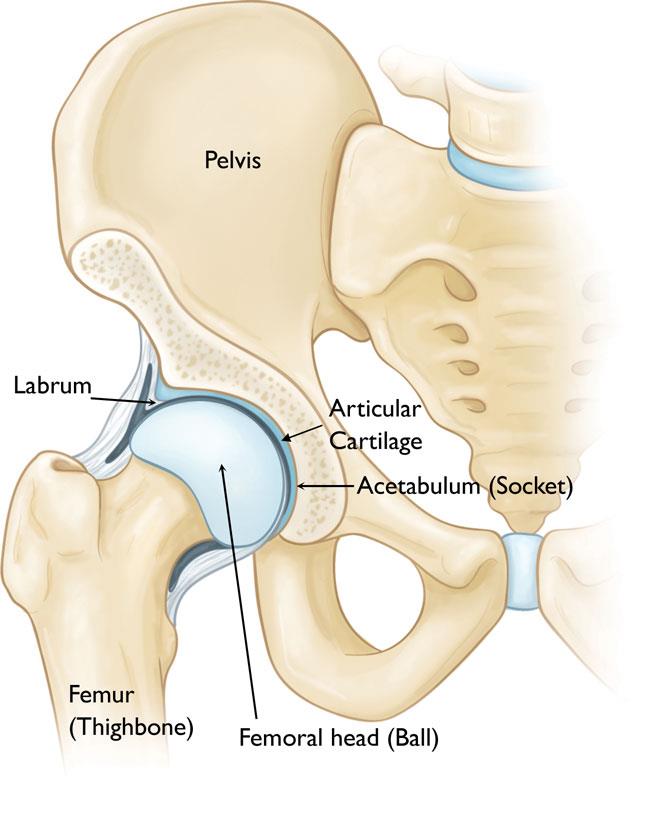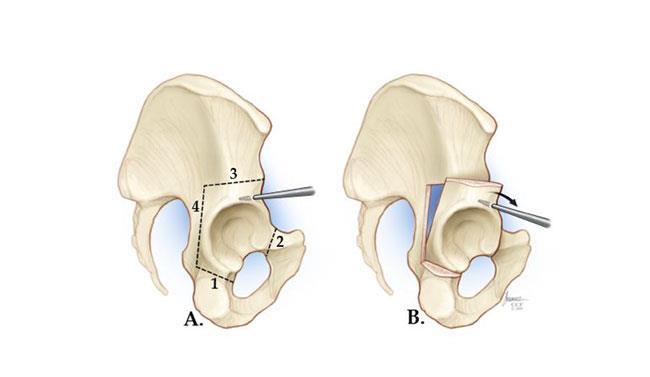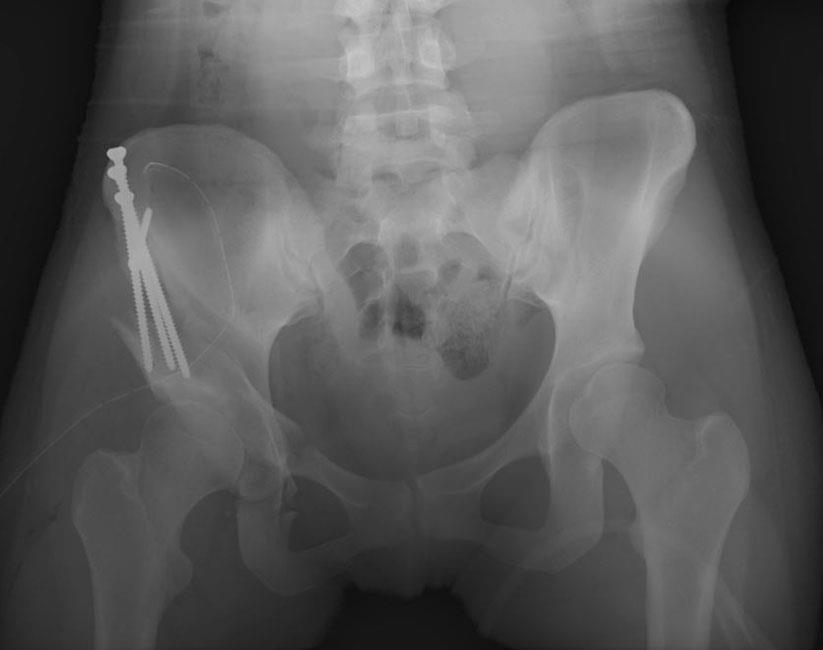Diseases & Conditions
Adolescent Hip Dysplasia
The hip is a ball-and-socket joint. In a normal hip, the ball at the upper end of the femur (thighbone) fits firmly into the socket, which is a curved portion of the pelvis called the acetabulum.
In a young person with hip dysplasia, the hip joint has not developed normally — the acetabulum is too shallow to adequately support and cover the head of the femur. This abnormality can cause a painful hip and the early development of osteoarthritis, a condition in which the articular cartilage in the joint wears away and bone rubs against bone.
Adolescent hip dysplasia is usually the end result of developmental dysplasia of the hip (DDH), a condition that occurs at birth or in early childhood. Although infants are routinely screened for DDH, some cases remain undetected or are mild enough that they are left untreated. These patients may not show symptoms of hip dysplasia until they reach adolescence.
Treatment for adolescent hip dysplasia focuses on relieving pain while preserving the patient's natural hip joint for as long as possible. In many cases, this is achieved through surgery to restore the normal anatomy of the joint and delay or prevent the onset of painful osteoarthritis.
Anatomy
The hip is one of the body's largest joints. It is a ball-and-socket joint:
- The socket is formed by the acetabulum, which is a part of the large pelvic bone.
- The ball is the femoral head, which is the upper end of the femur (thighbone).
The bone surfaces of the ball and socket are covered with articular cartilage, a smooth, slippery substance that protects and cushions the bones and enables them to move easily.
The acetabulum is ringed by strong fibrocartilage called the labrum. The labrum forms a gasket around the socket, creating a tight seal and helping to hold the femoral head in place.
Description
In patients with hip dysplasia, the acetabulum is shallow, meaning that the ball, or femoral head, cannot firmly fit into the socket.
This abnormality changes the way force is normally transmitted between the bone surfaces. The labrum can end up bearing the forces are normally distributed evenly throughout the hip joint. In addition, more force is placed on a smaller surface of the hip cartilage and labrum. Over time, the smooth articular cartilage becomes frayed and wears away and the labrum becomes torn or damaged. These degenerative (gradual) changes can lead to early osteoarthritis.
The severity of hip dysplasia can vary from patient to patient:
- In mild cases, the head of the femur may simply be loose in the socket.
- In more severe cases, there may be complete instability in the joint and/or the femoral head may be completely dislocated out of the socket.
Cause
Adolescent hip dysplasia usually results from developmental dysplasia of the hip (DDH) that is undiscovered or untreated during infancy or early childhood.
DDH can occur in families, passed on from one generation to the next. It can be present in either hip, though it usually affects the left hip. It can occur in anyone but occurs more often in:
- Girls
- Firstborn children
- Babies born in the breech position (bottom-down instead of head-down)
Symptoms
Hip dysplasia in younger children is not a painful condition. However, over time, pain results when the altered forces in the hip cause degenerative changes (gradual damage) to occur in the articular cartilage and the labrum.
In most cases, this pain is:
- Located in the groin area, although it may sometimes be more toward the outside of the hip
- Occasional and mild at first, but it may increase in frequency (how often you feel it) and intensity (how much it hurts) over time
- Worse with activity or near the end of the day
Some patients may also experience the feeling of locking, catching, or popping within the groin.
Doctor Examination
Physical Examination
During the physical examination, your child's doctor will discuss your child's medical history and symptoms. They will move your child's hip in different directions to assess the range of motion and duplicate the pain or discomfort your child is feeling.
Imaging Tests
In most cases, adolescent hip dysplasia can be diagnosed with just a physical exam. However, your child's doctor may order imaging tests to rule out other causes for your child's pain and to help confirm the diagnosis.
- X-rays. X-rays provide images of bone and will help your child's doctor assess the alignment of the acetabulum and femoral head. An X-ray can also show signs of arthritis.
- Computerized tomography (CT) scans. More detailed than a plain X-ray, a CT scan can help your child's doctor determine the severity of dysplasia.
- Magnetic resonance imaging (MRI) scans. MRI scans can create better images of the body's soft tissues than X-rays do. An MRI can help your child's doctor find damage to the labrum and articular cartilage.
Treatment
Treatment for adolescent hip dysplasia focuses on delaying or preventing the onset of osteoarthritis while preserving the natural hip joint for as many years as possible.
Nonsurgical Treatment
Your child's doctor may recommend nonsurgical treatment if your child has mild hip dysplasia and no damage to the labrum or articular cartilage. Nonsurgical treatment may also be tried initially for patients who have such extensive (bad) joint damage that the only surgical option would be a total hip replacement.
Common nonsurgical treatments for adolescent hip dysplasia include:
Observation. If your child has minimal symptoms and mild dysplasia, the doctor may recommend simply monitoring the condition to make sure it does not get worse. Your child will have follow-up visits every 6 to 12 months so the doctor can check for any worsening of pain, symptoms, or X-ray findings that may call for treatment.
Lifestyle modification. Your child's doctor may also recommend that your child avoid the activities that cause the pain and discomfort. For a child who is overweight, losing weight will also help to reduce pressure on the hip joint.
Physical therapy. Specific exercises can improve the range of motion in the hip and strengthen the muscles that support the joint. This can relieve some stress on the injured labrum or cartilage.
Medications. Nonsteroidal anti-inflammatory drugs (NSAIDs), such as ibuprofen and naproxen, can help relieve pain and reduce swelling in an arthritic joint.
In addition, cortisone is an anti-inflammatory agent that can be injected directly into a joint. Although an injection of cortisone can provide pain relief and reduce inflammation, the effects are temporary.
Surgical Treatment
Your child's doctor may recommend surgery if your child is experiencing pain and has limited damage to the articular cartilage in their hip.
The surgical procedure most commonly used to treat hip dysplasia is an osteotomy or "cutting of the bone." In an osteotomy, the surgeon reshapes and reorients the acetabulum and/or femur so that the two joint surfaces are in a more normal position.
There are different types of osteotomies that can be performed to treat hip dysplasia. The specific procedure the surgeon recommends will depend on a several factors, including:
- Your child's age
- The severity of the dysplasia
- The extent of damage to the labrum
- Whether osteoarthritis is present
- The number of remaining growing years
Periacetabular osteotomy (PAO). Currently, the osteotomy procedure most commonly used to treat adolescent hip dysplasia is a periacetabular osteotomy (PAO). "Periacetabular" means "around the acetabulum."
In most cases, PAO takes from 2 to 3 hours to perform. During the surgery;
- The surgeon makes four cuts in the pelvic bone around the hip joint to loosen the acetabulum.
- They then rotate the acetabulum, repositioning it into a more normal position over the femoral head. The surgeon will use X-rays to direct the bony cuts and to ensure that the acetabulum is repositioned correctly.
- Once the bone is repositioned, the surgeon inserts several screws to hold the bone in place until it heals.
Arthroscopy. In conjunction with PAO, your child's surgeon may use hip arthroscopy to repair a torn labrum.
During arthroscopy, the surgeon inserts a small camera, called an arthroscope, into the joint. The camera displays pictures on a video monitor, and the surgeon uses these images to guide miniature surgical instruments. Arthroscopic procedures may include:
- Labral refixation. In this procedure, the surgeon trims the torn and frayed tissue around the acetabular rim and reattaches the torn labrum to the bone of the rim.
- Debridement. In some cases, simply trimming the torn or weakened labral tissue can provide pain relief.
Complications
As with any surgical procedure, there are risks involved with PAO. Your child's surgeon will discuss each of the risks with you and will take specific measures to help avoid potential complications.
Although the risks are low, the most common complications include:
- Infection
- Blood clots
- Injuries to blood vessels and nerves
- Persistent (lasting) hip pain
- Failure of the osteotomy to heal (this is called a nonunion)
Recovery
Your child will remain in the hospital for 2 to 4 days after surgery. During this time, they will be monitored and given pain medication.
In most cases, full weight-bearing will not be allowed on the operated leg for 6 to 12 weeks while the bones heal in their new position. During this time, your child will need to use crutches.
About 6 weeks after surgery, your child will have a follow-up visit with the doctor. X-rays will be taken so the doctor can see how well the PAO has healed. During your visit, the doctor will determine when it is safe to put weight on the leg and when your child can begin physical therapy. The physical therapist will show your child specific exercises to help maintain range of motion and restore strength and flexibility in the hip joint.
Outcomes
Periacetabular osteotomy is usually successful in delaying the need for an artificial hip joint and relieving pain. Whether your child will need a total hip replacement in the future depends on several factors, including the amount of osteoarthritis that was present in the joint when the PAO was performed.
Last Reviewed
July 2023
AAOS does not endorse any treatments, procedures, products, or physicians referenced herein. This information is provided as an educational service and is not intended to serve as medical advice. Anyone seeking specific orthopaedic advice or assistance should consult his or her orthopaedic surgeon, or locate one in your area through the AAOS Find an Orthopaedist program on this website.









